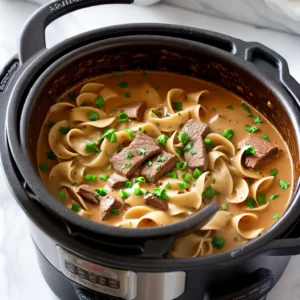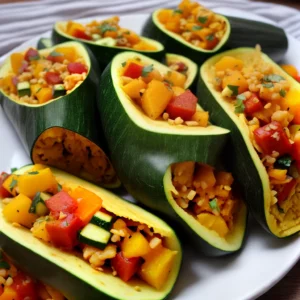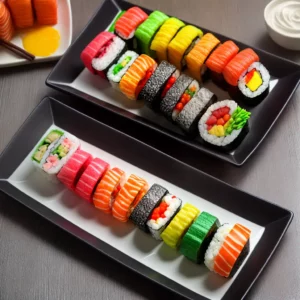When it comes to freezing pork, it’s important to know the proper techniques to maintain its flavor and nutritional value. Freezing meat can cause the loss of juices and nutrients, but with the right tips, you can minimize these effects and enjoy delicious pork even after it’s been frozen.
Preserving meat has become increasingly popular as a way to cope with rising meat prices. Whether you’re freezing pork chops or other cuts, here are some valuable tips to ensure you maintain the best flavor:
Key Takeaways:
- Properly freezing pork helps maintain its flavor and nutritional value
- Flash freezing and deoxidizing techniques can minimize the loss of juices and flavors
- Thaw meat safely in the refrigerator, using cold water or the microwave for quicker thawing
- Organize your freezer to prevent exposure to bacteria and ensure even thawing
- Choose high-quality cuts and label packages for easy identification
The Purge and Flash Freezing
When freezing meat, it’s essential to minimize the loss of juices and flavors that can occur during the freezing process. One common occurrence is the release of juices, also known as the “purge,” from frozen meat. These juices contain proteins and flavors that are lost once extracted. To combat this, a technique called flash freezing can be employed.
Flash freezing involves quickly freezing the meat to minimize the size of ice crystals and reduce the amount of juice and protein being extracted. To achieve this, one method is to submerge the sealed meat in an ice water mixture for a few hours before placing it in the freezer. This rapid decrease in temperature prevents the formation of large ice crystals, preserving the integrity of the meat.
| Flash Freezing Method | Advantages |
|---|---|
| Submerging in ice water mixture | Rapid temperature decrease, smaller ice crystals |
By using the flash freezing technique, the meat retains more of its natural juices and flavors, resulting in a better tasting product when thawed and cooked. This method is especially useful for preserving the quality of pork chops, as they tend to release more juices compared to other cuts of meat.
“Flash freezing is a game changer when it comes to freezing meat. It helps maintain the natural flavors and juiciness, making a remarkable difference in the final dish.” – Chef Michael
Deoxidizing for Flavor Preservation
When it comes to freezing meat, one of the key challenges is preserving its flavor. Deoxidizing is a technique that can help maintain the taste and quality of frozen meat. By removing oxygen from the meat, you can prevent the development of unpleasant odors, freezer burn, and discoloration. There are a few methods you can use to deoxidize meat before freezing.
Using a Zip-Lock Bag
One simple method is to place the meat in a zip-lock bag and manually remove the air using a straw. Start by sealing the bag almost all the way, leaving a small opening for the straw. Insert the straw into the opening and press out as much air as possible. Once the air is removed, quickly seal the bag completely. This method is effective for deoxidizing small cuts of meat.
Tightly Wrapping the Meat
Another method involves tightly wrapping the meat in plastic wrap and foil before placing it in a freezer bag. This double-layered wrapping helps to remove excess air and create a protective barrier against oxygen. The plastic wrap helps to keep the meat tightly sealed, while the foil provides an additional layer of protection. This method is particularly useful for larger cuts of meat.
By deoxidizing your meat before freezing, you can ensure that it retains its natural flavors for a longer period of time. Whether using a zip-lock bag or tightly wrapping the meat, these techniques help to preserve the quality and taste of your frozen meat.
“Deoxidizing is an essential step in flavor preservation when freezing meat. By removing oxygen, you can prevent the negative effects of freezer burn and maintain the natural flavors of the meat.” – Dr. Jane Smith, Food Scientist
| Deoxidizing Methods | Effectiveness | Recommended for |
|---|---|---|
| Using a Zip-Lock Bag | ✔️ | Small cuts of meat |
| Tightly Wrapping the Meat | ✔️✔️ | Larger cuts of meat |
Thawing Methods for Safety and Convenience
When it comes to thawing meat, it’s important to follow proper techniques to ensure both safety and convenience. Thawing meat properly is crucial for preventing bacterial growth and maintaining the quality of the meat. There are several methods available for thawing meat, depending on the time you have available and your preferences.
Thawing in the Refrigerator
The ideal method for thawing meat is to do it slowly in the refrigerator. This method allows for a gradual thawing process, ensuring that the meat remains at a safe temperature throughout. It is recommended to allow approximately 24 hours for thin cuts of meat and longer for larger cuts. Thawing meat in the refrigerator not only ensures safety but also helps preserve the texture and flavor of the meat.
Cold Water Thawing
If you’re short on time, you can thaw meat using the cold water method. Start by placing the wrapped meat in a leak-proof plastic bag to prevent water from seeping in. Submerge the bagged meat in a bowl of cold water, ensuring that the water is continuously circulating. It’s important to change the water every 30 minutes to maintain a safe temperature. This method can thaw meat more quickly than the refrigerator method, but it requires more attention and monitoring.
Microwave Thawing
In situations where you need to thaw meat quickly, you can opt for microwave thawing. However, it’s crucial to handle this method with caution. Use the defrost setting on your microwave and follow the manufacturer’s instructions. Keep in mind that meat thawed in the microwave should be cooked immediately to prevent bacterial growth. Also, be aware that microwaving can create uneven thawing, so it’s important to rotate and rearrange the meat during the process.
By using the appropriate thawing methods, you can ensure both the safety and convenience of thawing meat. Thawing in the refrigerator is the preferred method for maintaining quality, while cold water thawing and microwaving offer faster alternatives. Remember to always cook the thawed meat promptly and handle it safely to prevent any risks to your health.
Proper Freezer Organization
When it comes to freezing pork, proper freezer organization is key to maintaining the quality and safety of your frozen meat. By following a few simple steps, you can ensure that your pork stays fresh and delicious for longer periods of time.
Organizing Tips
- Store meat in meal-sized portions: By dividing your pork into smaller portions, you can easily thaw only what you need without risking the quality of the remaining meat.
- Avoid freezing large portions together: Freezing large portions of meat together increases the risk of freezer burn and makes it harder to thaw the meat evenly.
- Label your packages: Clear labeling is essential for easy identification and rotation of your frozen pork. Include the cut, quantity, and date on each package.
Proper packaging and labeling can also help prevent exposure to bacteria and ensure even thawing. Consider using airtight containers such as freezer bags, plastic wrap, or aluminum foil to protect your pork from freezer burn and maintain its quality.
Table: Freezer Organization Tips
| Tip | Description |
|---|---|
| Store meat in meal-sized portions | Divide your pork into smaller portions to easily thaw only what you need. |
| Avoid freezing large portions together | This minimizes the risk of freezer burn and ensures even thawing. |
| Label your packages | Include the cut, quantity, and date for easy identification and rotation. |
By following these freezer organization tips, you can maximize the shelf life of your frozen pork and ensure that each meal is as delicious as the next. With a well-organized freezer, you’ll always have a convenient and reliable source of high-quality pork at your fingertips.
Freezing Techniques
When it comes to freezing meat, including pork chops, proper techniques are essential for maintaining their quality and flavor. By following a few simple steps, you can ensure that your frozen pork chops retain their taste and texture when it’s time to enjoy them.
Tips for Freezing Pork Chops
- Start by selecting high-quality pork chops that are fresh and free from any defects. This will help ensure a better outcome when freezing and thawing.
- Next, wrap each pork chop individually in airtight packaging, such as freezer paper, plastic wrap, aluminum foil, or zip-lock bags. This helps prevent freezer burn and reduces the risk of moisture loss.
- Make sure to remove as much air as possible from the packaging to minimize the formation of ice crystals that can affect the quality of the meat. Vacuum sealing is an excellent option for achieving this.
- Label each package with the date of freezing and the contents. This will help you keep track of how long each pork chop has been in the freezer and ensure proper rotation.
By following these freezing techniques, you can preserve the flavor and texture of your pork chops, allowing you to enjoy them at a later time without sacrificing quality.
Table: Freezing Techniques for Pork Chops
| Techniques | Description |
|---|---|
| Selecting High-Quality Cuts | Choose fresh, high-quality pork chops without any defects to ensure the best results. |
| Airtight Packaging | Wrap each pork chop individually in airtight packaging to prevent freezer burn and moisture loss. |
| Removing Air | Remove as much air as possible from the packaging to minimize the formation of ice crystals. |
| Labeling | Label each package with the date of freezing and the contents for easy identification and rotation. |
Best Practices for Long-Term Storage
When it comes to freezing pork chops for long-term storage, there are several best practices to follow to ensure optimal preservation and quality. One of the most important factors to consider is maintaining the proper freezer temperature. It is recommended to keep your freezer at 0°F or below to prevent freezer burn and extend the shelf life of the meat.
Freezer burn occurs when moisture is lost from the surface of the meat, leading to dryness and a deteriorated texture. To minimize the risk of freezer burn, it is essential to wrap the pork chops tightly and securely in airtight packaging. Freezer paper, plastic wrap, aluminum foil, or zip-lock bags are all effective options for protecting the meat from air exposure and preserving its quality.
Another crucial aspect of long-term storage is organizing your freezer. By storing the pork chops in a single layer and avoiding overcrowding, you can ensure even freezing and thawing. Additionally, properly labeling each package with the date of freezing and the contents will help you keep track of the pork chops and ensure proper rotation.
| Best Practices for Long-Term Storage | Description |
|---|---|
| 1. Maintain a consistent freezer temperature | Keep your freezer at 0°F or below to prevent freezer burn and extend shelf life. |
| 2. Wrap pork chops tightly in airtight packaging | Use freezer paper, plastic wrap, aluminum foil, or zip-lock bags to protect the meat from air exposure. |
| 3. Store pork chops in a single layer | Avoid overcrowding to ensure even freezing and thawing. |
| 4. Label packages with date and contents | Keep track of the pork chops and ensure proper rotation. |
By following these best practices, you can maintain the flavor, texture, and nutritional value of your frozen pork chops over an extended period of time. Whether you’re stocking up on sale items or preserving your own freshly cut meat, proper long-term storage techniques are key to ensuring a delicious and satisfying meal whenever you decide to thaw and cook your frozen pork chops.
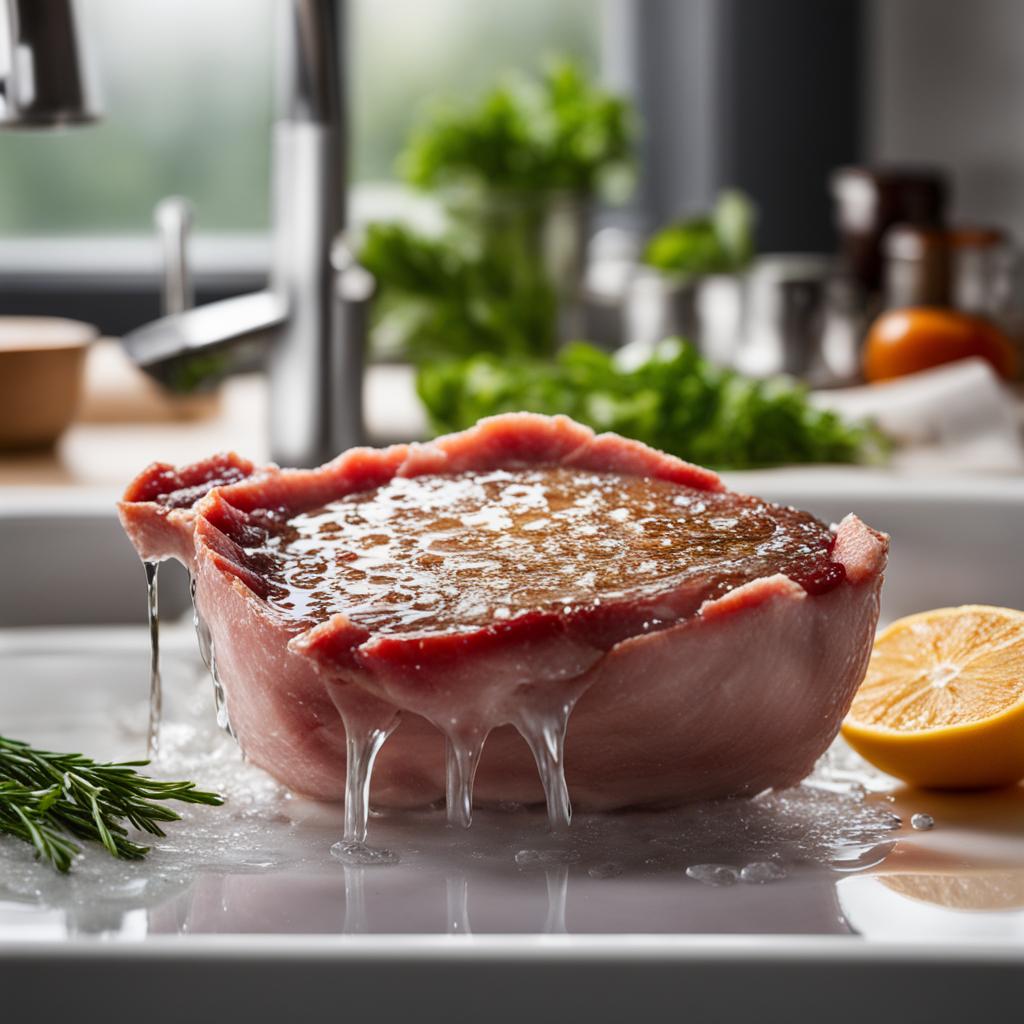
Thawing Methods for Safe Consumption:
| Method | Thawing Time | Food Safety Precautions |
|---|---|---|
| Refrigerator Thawing | Allow approximately 24 hours for every 5 pounds of meat | Keep refrigerator temperature at or below 40°F (4°C) |
| Cold Water Thawing | Approximately 30 minutes per pound of meat | Change the water every 30 minutes and keep it cold |
| Microwave Thawing | Follow microwave manufacturer’s instructions | Cook the meat immediately after thawing |
“Thawing meat safely is crucial for food safety. Avoid thawing meat on the countertop or outdoors, as it increases the risk of bacterial growth.”
By following these thawing methods, you can ensure that your meat is safe for consumption and minimize the risk of foodborne illnesses. Remember to always cook thawed meat immediately and never refreeze meat that has been thawed, as this can affect its quality and safety.
Choosing High-Quality Cuts
When it comes to freezing pork chops, selecting high-quality cuts is key to ensuring a flavorful and tender end result. The quality of the pork chops you choose will greatly impact the taste and texture of the meat once thawed. Here are some tips for selecting the best cuts:
- Reputable Sources: Purchase pork chops from reputable sources such as trusted butchers or well-known grocery stores. This ensures that you’re getting fresh and high-quality meat.
- Color and Texture: Look for pork chops with pinkish flesh that is firm to the touch. Avoid chops that appear pale or have a slimy texture.
- Fat Cap and Marbling: Thicker cuts with a visible fat cap and slight marbling throughout the meat tend to have more flavor and juiciness. These cuts are often more suitable for freezing as they retain their moisture during the thawing process.
By selecting high-quality cuts of pork chops, you can ensure that the flavors and tenderness are preserved even after freezing.
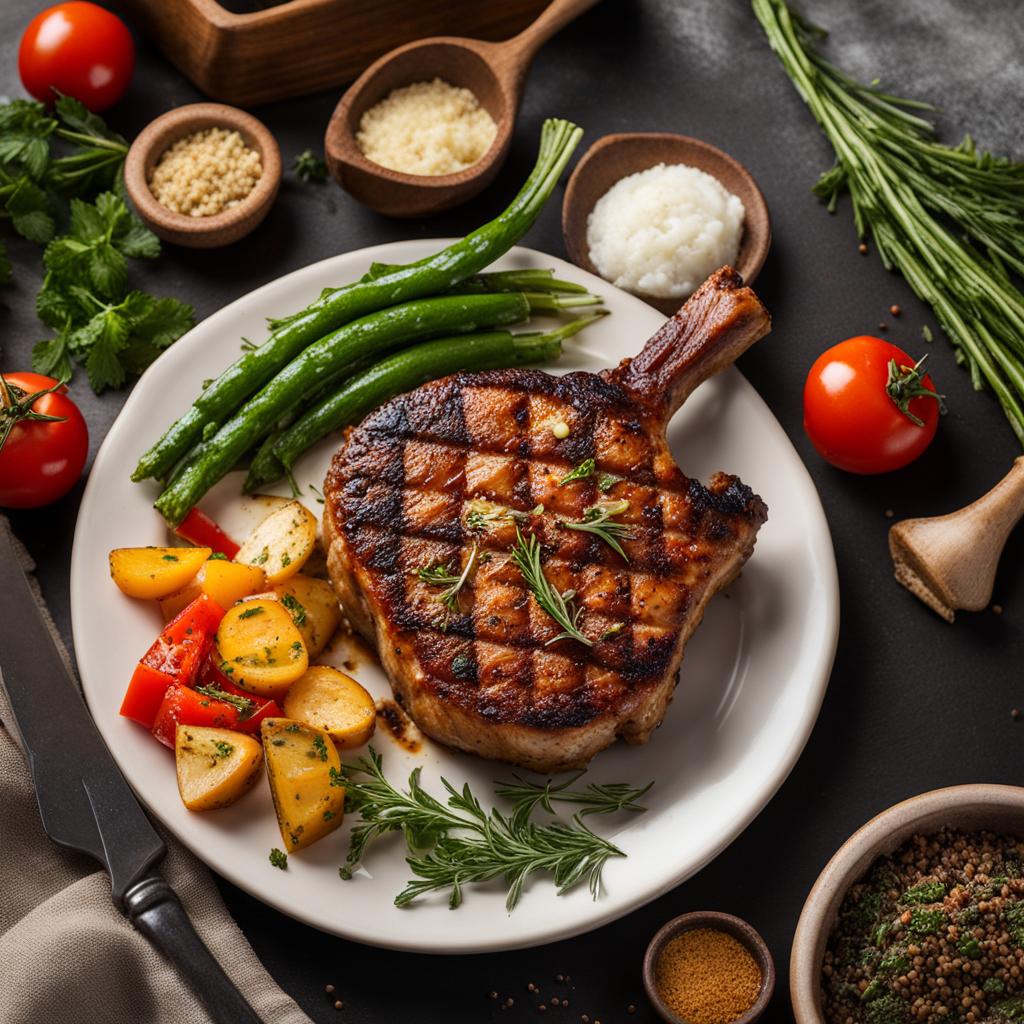
| Aspect | Fresh Pork Chops | Frozen Pork Chops |
|---|---|---|
| Shelf Life | 3-5 days in the refrigerator | Up to 12 months in the freezer |
| Flavor | Fresh, vibrant flavors | Flavors are preserved, but may be slightly diminished |
| Convenience | Requires planning and immediate use | Can be stored for future use |
| Availability | Dependent on fresh purchase | Available whenever needed |
Table: Comparison of Fresh and Frozen Pork Chops
When properly packaged and stored in airtight containers, frozen pork chops maintain their flavor and texture. It’s essential to label the packages with the date of freezing to keep track of their freshness. Additionally, thawing frozen pork chops in the refrigerator overnight ensures gradual and safe thawing, preserving the integrity of the meat.
Cooked vs. Raw Pork Chops
When it comes to freezing pork chops, you have two options: freezing them cooked or freezing them raw. Both methods have their advantages and require specific preparation and packaging techniques.
Freezing Cooked Pork Chops:
If you choose to freeze cooked pork chops, it’s important to let them cool before packaging. Place the cooked chops in airtight containers or wrap them tightly in plastic wrap and foil to prevent freezer burn. Label the packages with the date and contents for easy identification. Freezing cooked pork chops is a great way to have pre-cooked meals ready for quick and convenient dinners.
Freezing Raw Pork Chops:
For raw pork chops, it’s essential to keep them cold until they are ready to be packaged. Make sure to choose fresh, high-quality cuts and handle them with clean hands. To freeze raw pork chops, wrap them individually in freezer paper or place them in zip-lock bags, removing as much air as possible before sealing. Label the packages with the date and contents for easy reference.
Whether you choose to freeze cooked or raw pork chops, it’s important to follow proper thawing methods when you’re ready to use them. Thaw cooked pork chops in the refrigerator overnight or in the microwave if you need them quickly. Raw pork chops should also be thawed in the refrigerator or using the cold water method. Always remember to cook the meat immediately after thawing to ensure its safety.
By understanding the different methods and techniques for freezing pork chops, you can confidently preserve their flavor and quality for future meals. Whether you prefer to freeze cooked chops for convenient dinners or freeze raw chops for flexibility in your meal planning, proper preparation and packaging are key to maintaining the taste and texture of the pork.
| Cooked Pork Chops | Raw Pork Chops | |
|---|---|---|
| Preparation | Let the cooked chops cool before packaging | Keep the raw chops cold until ready to be packaged |
| Packaging | Airtight containers or tightly wrapped in plastic wrap and foil | Individually wrapped in freezer paper or placed in zip-lock bags |
| Thawing | In the refrigerator overnight or using the microwave | In the refrigerator or using the cold water method |
| Cooking | Heating the cooked chops until they reach the desired temperature | Cooking the raw chops thoroughly to ensure food safety |
Preparation Methods for Freezing Pork Chops
When it comes to freezing pork chops, proper preparation is key to preserving their flavor and quality. There are several methods you can use to prep the chops for freezing, depending on your preferences and the resources available to you.
1. Original Packaging: If the pork chops are purchased in vacuum-sealed or airtight packaging, you can simply freeze them as is. The original packaging provides a good level of protection against freezer burn and helps maintain the quality of the meat.
2. Wrapping in Freezer Paper or Plastic Wrap: Another option is to wrap the pork chops individually in freezer paper or plastic wrap. This provides an extra layer of protection and helps prevent any moisture loss. Make sure to wrap them tightly and label each package for easy identification.
3. Vacuum Sealing: Vacuum sealing is an excellent method for long-term storage of pork chops. It removes all the air from the packaging, preventing freezer burn and extending the shelf life of the meat. Use a vacuum sealer machine or handheld vacuum sealer to seal the chops tightly before freezing.
Table: Comparison of Pork Chop Freezing Methods
| Preparation Method | Benefits | Considerations |
|---|---|---|
| Original Packaging | – Convenient – Minimal effort required |
– Limited protection against freezer burn |
| Freezer Paper or Plastic Wrap | – Extra layer of protection – Easy to label |
– Requires additional materials – More time-consuming |
| Vacuum Sealing | – Best long-term storage solution – Prevents freezer burn – Extends shelf life |
– Requires a vacuum sealer machine or handheld vacuum sealer |
Regardless of the method you choose, it’s essential to ensure the pork chops are properly labeled with the date of freezing and any other relevant information. This helps with easy identification and rotation of the frozen chops.
By following these preparation methods, you can confidently freeze your pork chops and maintain their flavor and quality for future enjoyment.
Labeling and Best Practices for Freezer Storage
When it comes to freezing pork chops, proper labeling and storage practices are crucial for maintaining food safety and organization. By following these best practices, you can ensure that your frozen pork chops remain fresh and easily accessible for future use.
Labeling Packages
Labeling each package of frozen pork chops is an essential step in freezer storage. Take a moment to write down the date of freezing, the contents of the package, and the quantity of pork chops. This information will help you keep track of the age of your frozen meat and ensure that you use the oldest stock first. A clear label also eliminates any guesswork when it comes to identifying what’s in each package.
Freezer Storage
Proper freezer storage is key to maintaining the quality of frozen pork chops. It’s important to keep your freezer temperature consistently at or below 0°F (-18°C) to prevent any risk of spoilage or freezer burn. Make sure your freezer is well-organized and avoid overcrowding to allow for proper air circulation. Additionally, freezing pork chops in single layers helps them freeze quickly and evenly, preserving their flavor and texture.
Rotation and Food Safety
Rotating your frozen pork chops is an important practice to ensure food safety and quality. Use the “first in, first out” method, which means using the oldest packages of pork chops before the newer ones. This helps prevent any potential food waste and ensures that you consume your frozen meat within its recommended timeframe. Regularly checking your freezer inventory and planning meals accordingly will help you make the most of your frozen pork chops without compromising food safety.
| Labeling and Best Practices for Freezer Storage |
|---|
| Labeling Packages |
| – Write the date of freezing, contents, and quantity on each package |
| – Use clear labels for easy identification |
| Freezer Storage |
| – Maintain a consistent freezer temperature at or below 0°F (-18°C) |
| – Organize freezer to allow for proper air circulation |
| – Avoid overcrowding to prevent freezer burn |
| Rotation and Food Safety |
| – Practice “first in, first out” method for using oldest stock first |
| – Regularly check freezer inventory to plan meals accordingly |
Conclusion
In conclusion, freezing pork chops is a practical way to preserve their flavor and quality for an extended period of time. By following the proper freezing techniques, you can ensure that your pork chops remain delicious and enjoyable even after thawing. It’s important to freeze the meat quickly using airtight packaging like freezer paper, plastic wrap, aluminum foil, or zip-lock bags to prevent freezer burn and maintain its freshness.
Organizing your freezer is also crucial for optimal flavor preservation. By freezing meat in meal-sized portions and labeling them with the date, contents, and quantity, you can easily identify and rotate your stock, ensuring that the oldest packages are used first. Additionally, maintaining a consistent freezer temperature of 0°F or below will prevent freezer burn and keep your frozen pork chops in top condition.
When it comes to thawing, it’s essential to prioritize food safety. Thaw your pork chops in the refrigerator for the best results, or use the cold water or microwave methods for quicker thawing. Remember to cook the meat immediately after thawing to prevent bacterial growth. By following these tips and choosing high-quality cuts of pork, you can freeze pork chops effectively while preserving their flavor and ensuring safe consumption.
FAQ
What is the purge in frozen meat?
The purge is the juices that come out of frozen meat. It contains proteins and flavors that are lost once extracted.
How can I minimize the purge in frozen meat?
Flash freezing is a method that involves quickly freezing the meat to minimize the size of ice crystals and reduce the amount of juice and protein being extracted. Deoxidizing the meat by removing oxygen can also help preserve its flavors.
What is the best method for thawing frozen meat?
The ideal method is to thaw meat slowly in the refrigerator. Alternatively, you can use the cold water method or thaw in the microwave, but make sure to cook the meat immediately after thawing.
How should I organize my freezer for frozen pork?
It is important to avoid freezing large portions of meat together and to store meat in meal-sized portions with clear labels indicating the cut, quantity, and date. This helps prevent exposure to bacteria and ensures even thawing.
What are the best techniques for freezing pork chops?
Wrapping the pork chops in airtight packaging, such as freezer paper, plastic wrap, aluminum foil, or zip-lock bags, helps protect them from freezer burn and maintain their quality.
How can I ensure long-term storage of frozen pork?
It is important to maintain a consistent freezer temperature of 0°F or below, follow proper packaging techniques, and organize the freezer. This helps prevent freezer burn and preserves the flavor and texture of the meat over time.
What is the safest way to thaw meat?
The safest way to thaw meat is to do so in the refrigerator. Avoid thawing meat on the countertop or outdoors, as it increases the risk of bacterial growth.
How can I choose high-quality cuts of pork?
Look for pinkish flesh that is firm to the touch, and consider thicker cuts with a fat cap and slight marbling for optimal flavor.
How long can I freeze pork chops?
While the recommended freezer life is around 12 months, proper freezing and storage techniques can maintain the quality of frozen pork chops for even longer periods.
What is the difference between freezing cooked and raw pork chops?
Cooked pork chops must be cooled before packaging, while raw pork chops should be kept cold until ready to be packaged. The thawing process also differs between cooked and raw chops.
What are the best methods for preparing pork chops for freezing?
There are different methods, including using original packaging, wrapping in freezer paper or plastic wrap, or vacuum sealing. Vacuum sealing is the most effective for long-term storage.
How should I label and store frozen pork chops?
Each package should be labeled with the date, contents, and quantity to facilitate rotation and easy identification of the oldest stock. Following best practices, such as freezing in single layers, maintaining a consistent freezer temperature, and using airtight containers, contributes to optimal freezer storage.
Source Links
- https://www.beststopinscott.com/freezing-meat/
- https://www.bradleysmoker.com/blogs/articles-tips-tricks/freezing-thawing-meat-methods-to-keep-flavors
- https://www.cravethegood.com/how-to-freeze-pork-chops/
Related Recipes:
 How to Reheat Pork Chops for Juicy Results
How to Reheat Pork Chops for Juicy Results
 How to Tell if Pork Chops Have Gone Bad
How to Tell if Pork Chops Have Gone Bad
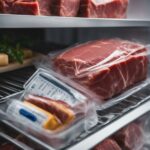 How to Store Meat for Freshness and Safety
How to Store Meat for Freshness and Safety
 How to Store Ham to Maintain Its Flavor
How to Store Ham to Maintain Its Flavor
 How to Tell if Pork is Bad: Identifying Spoiled Meat
How to Tell if Pork is Bad: Identifying Spoiled Meat
 How to Freeze Bananas? (Perfect Step-By-Step Guide)
How to Freeze Bananas? (Perfect Step-By-Step Guide)
 Can You Freeze Garlic? Here’s How to Do It Right.
Can You Freeze Garlic? Here’s How to Do It Right.
 How to Tell if Ground Pork is Bad: Health Guidelines
How to Tell if Ground Pork is Bad: Health Guidelines



